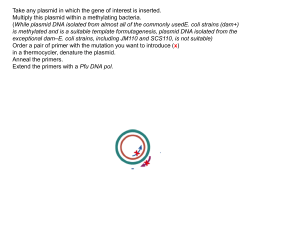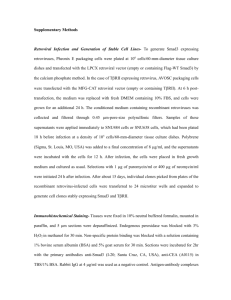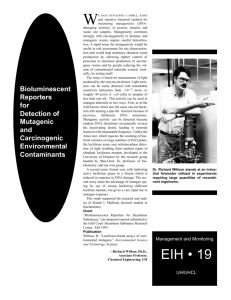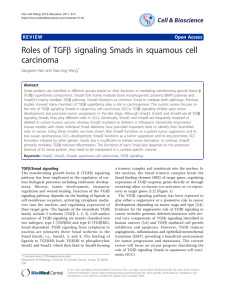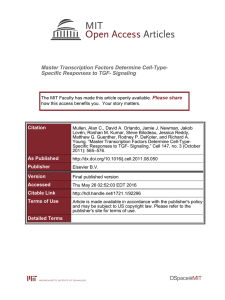Max Golden
advertisement
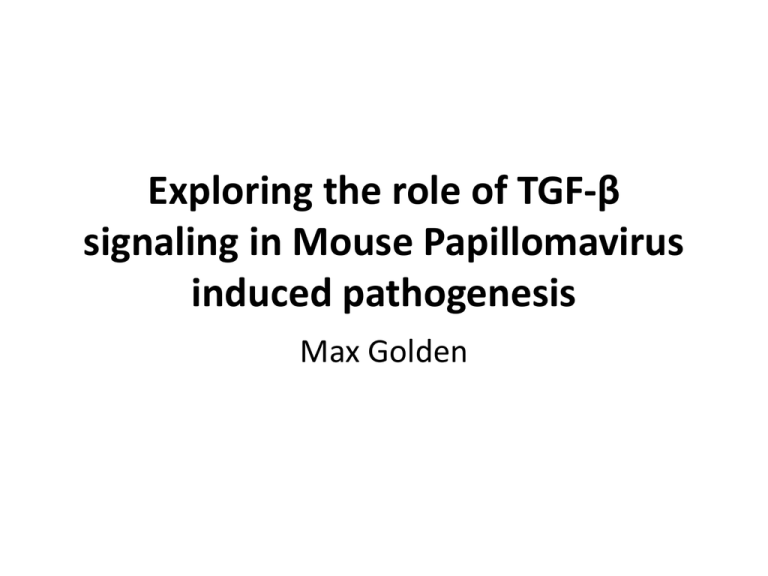
Exploring the role of TGF-β signaling in Mouse Papillomavirus induced pathogenesis Max Golden Abstract Human Papillomavirus (HPV) is a double stranded DNA virus that is implicated in genital and head and neck cancers in humans. Papillomaviruses are strictly species tropic and currently there is no tractable infection model to study these viruses in a laboratory setting. In this light, the recent discovery of Mouse Papillomavirus (MmuPV1), as the first ever papillomavirus to naturally infect laboratory mice provides us the unique opportunity to understand the biology of papillomaviruses in a genetically manipulatable host. Preliminary studies by our collaborators at Dr. Karl Munger’s lab (Harvard University) have shown that the viral protein E6 of MmuPV1 inhibits transforming growth factor beta (TGF-β) signaling potentially by interacting with the cellular SMAD3 protein, which is a downstream regulator of the TGFβ signaling pathway. We want to understand whether inactivation of TGFβ signaling by MmuPV1 E6 protein plays a critical role in MmuPV1 pathogenesis. The Munger lab is currently in the process of identifying MmuPV1 E6 mutants that are selectively altered in their ability to bind to SMAD3. However, structural analysis of E6 proteins in both HPV16 and BPV (Bovine Papillomavirus) has led to the hypothesis that it may be difficult to generate a functional E6 mutant deficient in the ability to interact with SMAD3. If this were true, then it will be difficult to use this approach for studying the biology of the E6 protein. Therefore we are trying to use an alternative approach by identifying a SMAD3 mutant which is deficient in its ability to bind E6, but retains other biological properties of SMAD3. A panel of SMAD3 mutants were generated in Dr. Michael Hoffman’s lab which were disrupted in their binding to some but not all Smad binding partners. We intend to test these mutants for their ability to bind E6 using a high-throughput screening luminescence based interactome mapping (LUMIER) assay. We have been successful in optimizing the LUMIER assay in the context of MmuPV-1 E6. optimized and performed several successful LUMIER assays. Now that we have a working assay, we want to identify mutants of SMAD3 that are selectively defective for binding E6. Our eventual goal is to be able to use the identified mutant to generate a transgenic mouse strain which can be used to understand MmuPV-1 biology. Hypothesis Inactivation of TGFβ signaling by MmuPV1 E6 protein plays a role in pathogenesis Problem Mutating E6 in papillomavirus proteins has pleiotropic effects on the overall function of E6 Potential Solution Identify a SMAD3 mutant that does not bind MmuPV-1 E6 but retains other biological functions Approach Using a high throughput screening luminescence based interactome mapping (LUMIER) assay to identify SMAD3 mutants Experimental Design Generation of flag tagged MmuPV-E6 plasmids Expansion of flag tagged MmuPV-E6 plasmids Optimization of LUMIER assay using flag tagged E6 and known SMAD3 binding partners Using optimized assay for identifying SMAD3 mutants that do not bind E6 Testing identified mutants in tissue culture for their ability to rescue TGF-beta signaling Description of LUMIER After completing a maxiprep with our plasmid DNA, we began the LUMIER assay. In this assay, renilla luciferase-tagged partners, ALK5, and FLAG-tagged partners are transfected into HEK 293 cells using TransIT-LT1 transfection reagent (from Mirus). The next day, a high throughput co-immunoprecipitation is done. The wells of a plate are pre-coated with G-protein antibody, which pulls down the FLAG-tagged partner. If the E6 has binded to the renilla-tagged partner, the entire protein complex will be pulled down and the luciferase will give off a signal. We also used Alk5, a TGF-beta type 1 receptor which phosphorylates SMAD3 and increases binding. A LUMIER assay is split into three steps and is done across three days. The first step involves seeding cells for transfection. To do this, we seed 10^5 cells/well of a 12 well plate. The next step was to perform a LUMIER transfection. In order to perform the LUMIER assay, we begin by preparing an anti-flag coated 96-well plate by coating each well with 0.008 µg anti-flag antibody. 15µl of the sample is collected for analysis of total luminescence activity and the remaining 185 µl is incubated on the anti-flag coated plate and incubated at 4 oC on plate shaker for 2 hours. The assay was developed using the dual-glo Luciferase assay reagents (Promega) as per manufacturer’s instructions and luciferase counts were read using a plate reader. Methods: LUMIER Workflow Flag tagged partner Renila tagged partner 1. Read total renilla luciferase activity to evaluate transfection efficiency Lyse Cells 2. Read activity of CO-IP HEK293 Cells Flag tagged partner Renila tagged partner Anti-flag coated G-protein plate Results Fig. 1 Verifying presence of plasmid DNA using agarose gel electrophoresis Fig. 1 Flag tagged E6 plasmids were provided to us by the Munger lab. Our first task was to verify the presence of plasmid DNA shared with us by our collaborators in the Munger lab via agarose gel electrophoresis. The ladders were resolved well in lanes 1 and 5. Lanes 2, 3, and 4 show the presence of supercoiled, relaxed, and nicked forms of plasmid DNAs. Fig. 2 Bacterial transformation using flag-tagged E6 plasmids Results of bacterial transformation (Table 1) Plate Number Label/Type Colonies (Number) 1. Positive Control (pUC 19 plasmid) >20 2. Negative Control (No DNA) 0 3. CMV-N-mE6 >100 4. CMV-C-mE6 >100 Flag tagged E6 plasmids (CMV-N-mE6 Transformation of E. Coli with CMV-N-E6 (Fig. 2) and CMV-C-mE6) were transformed into E.Coli cells, and plated on LB-amp plates. Number of colonies that grew after 24 hours are shown in Table 1. Fig.2 shows an example of a transformed plate with bacterial colonies Fig. 3 Small scale preparation of plasmid DNA from transformed bacteria Plasmid DNA isolation by miniprep (Fig. 3) I then performed a miniprep using a QIAGEN kit to isolate and purify our plasmid DNA and verified presence of plasmid DNA via agarose gel electrophoresis. I used the plasmid vector pUC19 as a size reference since it is known that pUC19 is about 3000 base pairs. Lanes 2 through 7 showed the presence of supercoiled, relaxed, and nicked forms of plasmid DNAs. Lanes 8 and 9 showed the presence of pUC19, which was our positive control. From our results, we were able to verify that plasmid DNA was present and that our miniprep had been successful. Fig. 4: Large scale preparation of plasmid DNA UV Spectrophotometer Readings (Table 2) S. No. Sample Type OD260 260/280 (from spec) (from spec) Dil. Factor Conc. (µg/ml) Conc. (µg/µl) OD*DF*50 Conc.(µg/ml) /1000 1 CMV-C-mE6 .1682 1.8156 200 1682 1.682 2 CMV-N-mE6 .1878 1.8107 200 1878 1.878 Presence of linear DNA confirmed by restriction analysis (Figure 4) After conducting a successful miniprep, a maxiprep was then done to isolate and purify large amounts of plasmid DNA. We assessed the purity and quantity of DNA by UV spectrophotometry (Table 2). The DNA isolated had a 260/280 ratio of 1.8, which meant that the DNA was pure and not contaminated by RNA or proteins. We also set up a restriction enzyme digestion using BamH1 (which linearizes the DNA) and ran an agarose gel to confirm the correct size (Fig. 4). Fig. 5: COIP Luciferase expressed as a percentage of total luciferase of lysate COIP Luciferase/total Luciferase expressed as percentage 2.5 2 1.5 1 0.5 0 Percentage TrxGA Smad4 N-E6 C-E6 0.01979315 1.912229939 0.714163611 0.457239453 The amount of luciferase activity in cells transfected with each of the indicated proteins that coimmunoprecipitated with Smad3 is shown. TrxGA is the negative control vector, whereas the Smad 4 serves as the positive control since it interacts strongly with Smad 3. Both the n-terminal and c-terminal tagged viral E6 proteins interacted with Smad3. Fig. 6: Titrating the amount of Flag tagged E6 keeping Smad3 constant Conclusion We have verified that E6 binds to Smad3 via LUMIER assay Future Directions • We want to identify mutants of SMAD3 that are selectively defective for binding E6 and to then perform follow-up studies in tissue culture to confirm that the ability of E6 to bind to SMAD3 is required for E6 to inactivate the TGF-beta signaling pathway.
